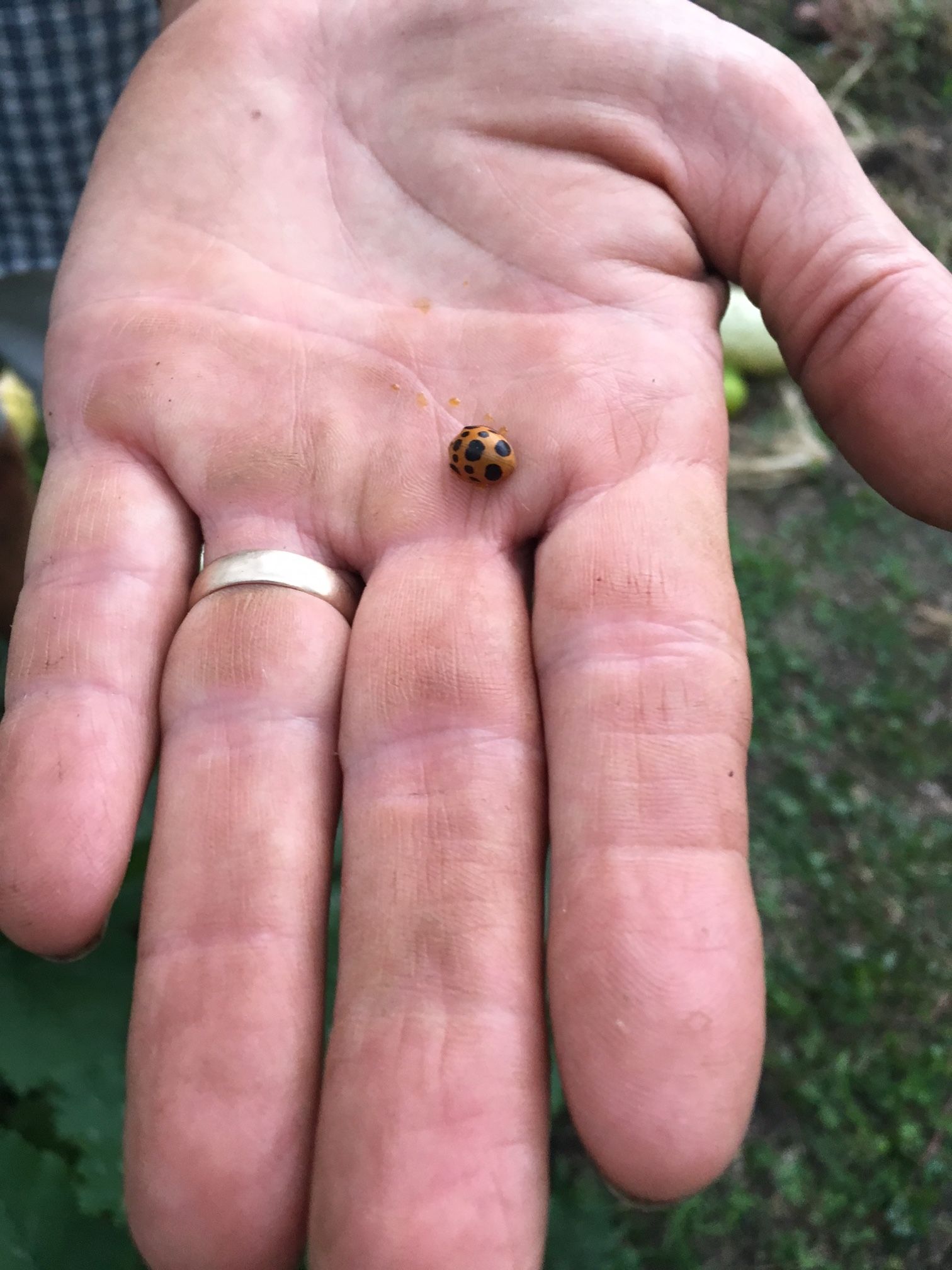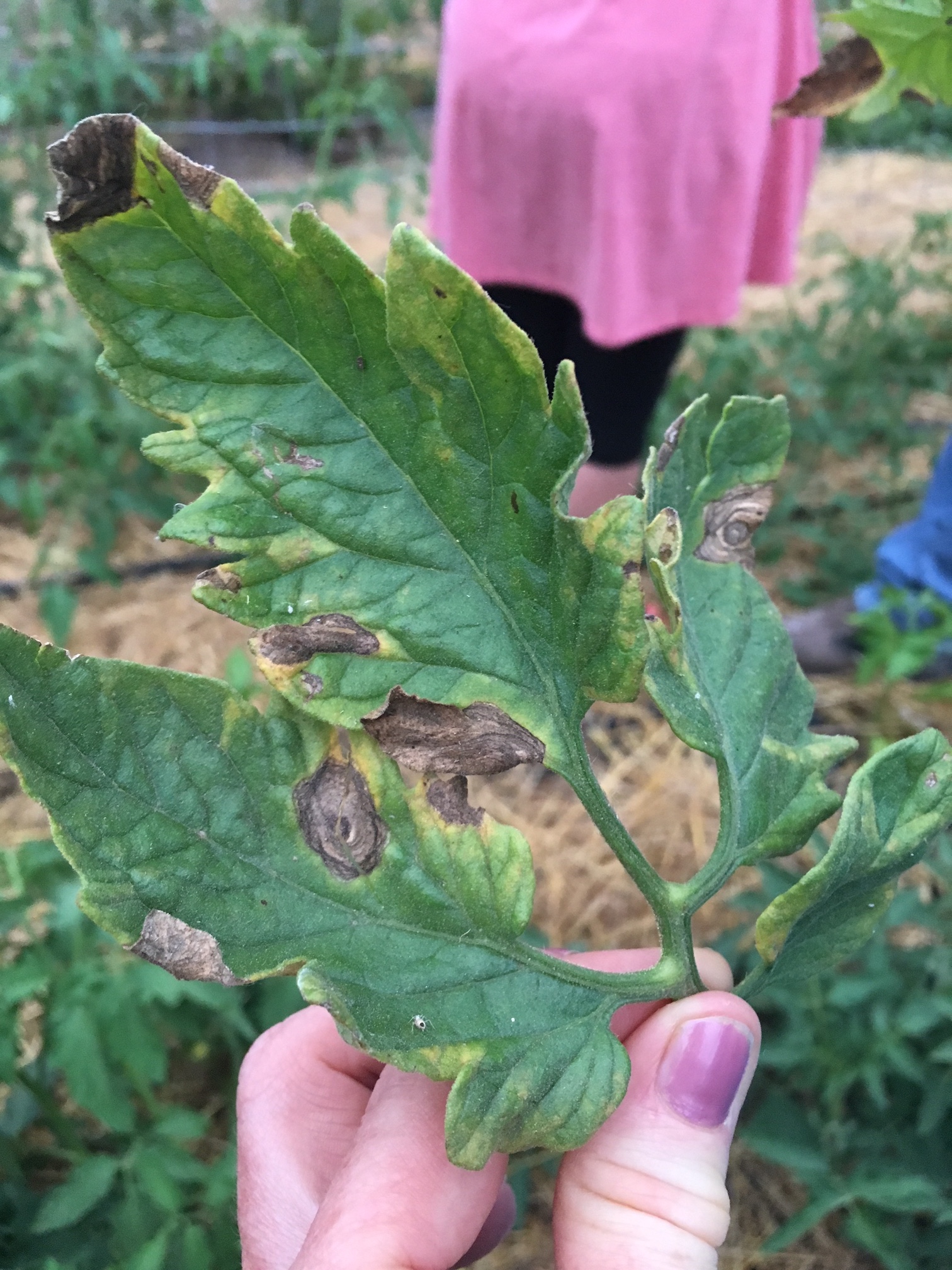
Organic Pest & Disease Control Workshop
The first week in July, CFI planned an organic pest and disease control workshop with Associate Professor of Environmental and Plant Biology, Art Trese. We met at the W. State St. Plant Biology Gardens, which grows food for the weekly plant sale at OU. As we met outside the gardens, we all noticed the dark ominous sky in the distance—in front of a bright sky, clouds churned together, forming shapes like smoke rising. A storm was definitely heading towards us.
Art’s plan was to walk around the garden and point out issues related to plant health. We started outside and headed under the greenhouse just in time before the rain hit. As we continued the rest of the workshop in the greenhouse, we had to speak loudly to talk over the sound of the rain hitting the roof.

Art said the trick with pests and diseases is to figure out which issues are cosmetic versus when they impact plant quality. First, we learned the difference between a bug and a beetle. This is not something I had ever really considered before. A beetle has a hard shell with wings that fold under it. Bugs don’t have this and they also don’t have a metamorphosis stage, meaning they hatch from eggs as smaller versions of their adult selves (nymphs) but they are never larva.
We then talked about specific beetles and bugs that become pesky in your vegetable garden:
- The harlequin is a bug likes to eat cabbage, broccoli, cauliflower, squash, or other plants. It got its name because it has a fancy orange and black “outfit.” They like the cleome plant, so one thing you can do is plant cleomes to “trap them” and then look for the bugs and squish them. Other than this, harlequin bugs are hard to control. You can’t spray for them because they’re not chewing anything. Instead, they inject their saliva into the leaf and then suck it back out, creating big zones of dead tissue on the leaves.
- Squash vine dwellers, much like their name suggests, bore into the vines of squash. You can prevent them from invading your squash plants by putting a floating row cover over your squash plants until the time they are about ready to flower. This way the female moth can’t get to them. Another solution is to plant many zucchini plants and then get rid of the plants that have been infected.
- Squash beetles look a bit like lady bugs (but more rust colored) and they lay eggs on squash leaves. Squish them if you find them, but they are not usually a big deal.
- Squash bugs are related to stink bugs, so they look similar to a stink bug. They eat squash and have copper red eggs. When you find a bunch of these eggs on the bottom of a squash leaf, scrape them off with your fingernails or put the leaf far from your squash plant—the larva can only survive on squash plants.
Other pests:
- Art says that “groundhogs are all but impossible.” He says you can put food out in a live trap and see if anything is irresistible to them. Some people say marshmallows or cantaloupe work, although he has not had much luck with either of these. The other possible solution is to keep bothering them by finding their burrow and closing it up. But often if you get rid of one, another one moves in. Another idea is to put fencing around your garden and burry the fence posts deep in the ground.
We discussed funguses that impact tomato and pepper plants:
- Septoria is a fungus that infects the leaves of tomato plants. You will notice tiny little brown spots that start to appear (likely) on the bottom leaves. It spreads upwards. The leaves might then turn yellow and then brown. Plants get septoria from infected rain water splashing up onto the leaves. It is hard to prevent plants from getting infected. The septoria spores are very tiny—Art says “they’re everywhere.” You can try to prevent getting it by mulching down at the bottom of the plant (although Art says this will likely just delay the fungus) and then pulling off the leaves near the bottom that look infected (but don’t compost these). Septoria does not infect the fruit of the plant, but infects the leaves so that if it spreads, it is difficult for the plant to sprout new flowers. Art chose to plant his tomatoes under shelter to keep them from getting septoria.
- Alternaria is another fungal disease that affects tomatoes. You can identify alternaria by its large brown spots on the leaves and “target rings” (brown circles with rings in them like a bullseye). Alternaria can cause the fruit on the plant to rot. This blight is also caused from water splashing up onto the plant leaves. Alternaria is particuarily an issue in humid climates. Mulching can also help avoid this type of tomato blight. Make sure to plant your tomatoes far enough apart and to avoid watering the plants from overhead.
- Blight in peppers. This blight is also caused by hard rain. When it rains hard, water goes into the stemmata. If you’re going to get hard rain, cover your plants and this can help prevent the blight.
Last, we discussed organic pest control products. You can get a lot of these products and have many of your questions answered at White’s Mill.
- Captain Jack’s “Flower and Vegetable Garden Dust.” This product is good for leaf-eating bugs. Spinosad is the active ingredient, and it is harmless no matter how much you use. It comes in a power so you have to find a way to sprinkle it on there. Art uses a dispenser, but suggested people eat home get a quart jar, put some insect netting over it, put the powder in the jar, and shake it on the leaves of your plants.
- Liquid Fense’s “Deer and Rabbit Repellent” is good for deer. It has garlic and putrefied eggs in it. (As you may guess, it does not smell particularly good.
- “Slug Magic” works as slug bait. The iron phosphate kills the slugs.
- Earth-tone “Insecticide Soap” is another organic gardening tool that kills aphids and other bugs.
- Art is not a big fan of diatomaceous earth. He says it does not work for bugs that have a harder outside cuticle.

